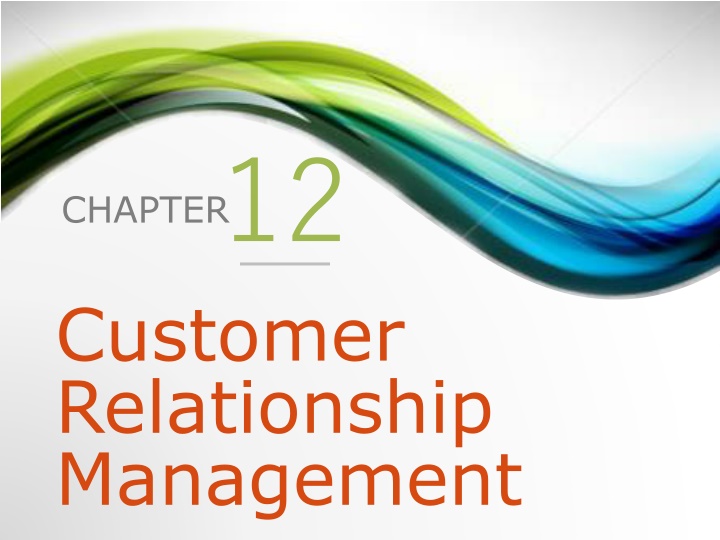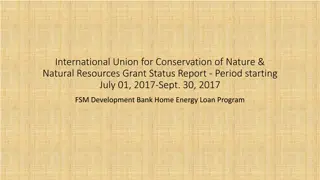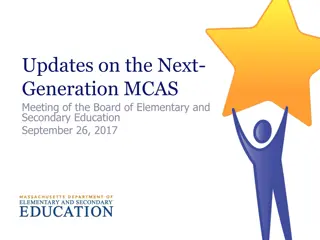
Effective Strategies for Customer Relationship Management
Explore the various aspects of Customer Relationship Management (CRM) including defining CRM, operational and analytical CRM systems, types of CRM systems, advantages and disadvantages of mobile, on-demand, and open-source CRM systems. Learn about the value of online customer service, Amazon's customer relationship management focus, and the importance of CRM in a customer-driven environment.
Uploaded on | 3 Views
Download Presentation

Please find below an Image/Link to download the presentation.
The content on the website is provided AS IS for your information and personal use only. It may not be sold, licensed, or shared on other websites without obtaining consent from the author. If you encounter any issues during the download, it is possible that the publisher has removed the file from their server.
You are allowed to download the files provided on this website for personal or commercial use, subject to the condition that they are used lawfully. All files are the property of their respective owners.
The content on the website is provided AS IS for your information and personal use only. It may not be sold, licensed, or shared on other websites without obtaining consent from the author.
E N D
Presentation Transcript
CHAPTER12 Customer Relationship Management
1. Defining Customer Relationship Management 2. Operational Customer Relationship Management Systems 3. Analytical Customer Relationship Management Systems 4. Other Types of Customer Relationship Management Systems
>>> 1. Identify the primary functions of both customer relationship management (CRM) and collaborative CRM strategies. 2. Describe how businesses might utilize applications of each of the two major components of operational CRM systems. 3. Discuss the benefits of analytical CRM systems to businesses.
>>> 4. Explain the advantages and disadvantages of mobile CRM systems, on-demand CRM systems, and open-source CRM systems.
OPENING > Rating Online Customer Service Why is it so valuable for an online retailer to be able to post StellaService s seal of approval on its Web site and advertising materials? Why doesn t StellaService provide the same service for bricks-and-mortar retailers?
12.1 Defining Customer Relationship Management Customer Touch Points Data Consolidation
S ABOUT BUSINESS 12.1 Amazon: Truly Superb Customer Service Describe the advantages that Amazon has over bricks-and-mortar retailers. Describe the many facets of Amazon s relentless focus on customer relationship management.
What Is CRM? 1. A true CRM integrates corporate strategy, business methodology, and technology to accomplish a myriad of goals for companies that want to operate in a customer-driven environment. 2. No business can survive without understanding its customers and having a positive relationship with them. 3. CRM provides support for the front-end customer facing functionality (e.g., marketing, sales, and customer service), which are usually not available in traditional ERP systems.
CRM Evolution 1. In the 1980s through the mid-1990s companies started using IT to automate customer processes with discrete customer-centric applications. 2. Late 1990s, companies started integrating these discrete systems into what is now known as CRM. 3. CRM began in response to a changing market environment as mass marketing gave way to focused segment marketing, and finally to target marketing an individual. 4. Enabled by new technologies that collected consumer data, companies progressed to focused segment marketing.
Customer Relationship Processes A good CRM should provide support for the following functions. Capture and maintain customer needs, motivations, and behaviors over the lifetime of the relationship. Facilitate the use of customer experiences for continuous improvement of this relationship. Integrate marketing, sales, and customer support activities measuring and evaluating the process of knowledge acquisition and sharing. 12
12.2 Operational Customer Relationship Management System Customer-Facing Applications Customer-Touching Applications
Customer Facing Applications Customer Service and Support Sales Force Automation Salesforce.com Marketing Campaign Management
Customer Facing Applications: Customer Service & Support Customer Interaction Centers (CIC) Call Center Oubound Telesales Inbound Teleservice Knowledge base Information Help Desk Live Chat Natural language processing
Live Chat 17
Customer Facing Applications: Sales Force Automation Contact Management System No redundant calls Sales Lead Tracking System ID cust who are likely to purchase a pdt Sales Forecasting System Product Knowledge System Configurator Build your own (PC; NIKE; )
Customer Facing Applications: Marketing Data Mining Cross-Selling Upselling Bundling
Customer Facing Applications: Campaign Management Campaign Planning Right messages Right people Analytical CRM Right channels Marketing communications opt-out
Customer Touching Applications Search & Comparison Capabilities Technical and Other Information and Services Customized Products and Services Mass Customization Personalized Web Pages Frequently Asked Questions (FAQs) E-mail and Automated Response Loyalty Programs Customers can use these to help themselves
12.3 Analytical Customer Relationship Management (CRM) Systems Analytical CRM Systems Analyze Customer Data for: Targeted marketing campaigns Increasing customer acquisition, cross- selling, and upselling Products and services decision support Financial forecasting Customer profitability analysis
Figure 12.3: Relationship Between Operational CRM & Analytical CRM What s missing here?
12.4 Other Types of Customer Relationship Management Systems On-Demand CRM Systems Mobile CRM Systems Open-Source CRM Systems Social CRM Comment: the title of this section
On-Demand CRM Systems On-Premise CRM Systems versus On- Demand CRM Systems Benefits of On-Demand CRM Systems Potential Problems with On-Demand CRM Systems
On-Demand CRM Systems: Benefits Reduced cost when compared to purchasing the system Reduced maintenance costs Employees only need to know how to access and utilize the system
On-Demand CRM Systems: Potential Problems Unreliable vendors Hosted software difficult to modify Upgrades only through the vendor Difficult integration with organization s existing software Information security & privacy risks
Open-Source CRM Systems Benefits of Open-Source CRM Systems Disadvantages of Open-Source CRM Systems Examples
Open-Source CRM Systems: Benefits Favorable pricing Wide variety of applications Easy to customize Updates and bug (software error) fixes rapidly distributed Extensive support information available for free
Open-Source CRM Systems: Disadvantages Risk related to quality control Company s IT platform must match development platform of open- source CRM system
Open-Source CRM Systems: Examples SugarCRM (www.sugarcrm.com) Concursive (www.concursive.com) Vtiger (www.vtiger.com)
Social CRM Provides two-way communication between organization & customers Organizations monitor social media sites and respond accordingly Customers obtain faster, better customer service
S ABOUT BUSINESS 12.2 uShip Benefits from SugarCRM Describe the advantages provided to uShip by the SugarCRM system. Describe the business needs of uShip that led to the company s decision to implement a CRM system.
S ABOUT BUSINESS 12.3 Morton s Steakhouse Surprises a Customer Explain how Morton s monitoring of social media illustrates how CRM is reviving personal marketing. Do you see any disadvantages in such close monitoring of social media? Provide specific examples to support your answer.













